Comparative Analysis of E-Government in Saudi Arabia and RoK
VerifiedAdded on 2022/09/27
|22
|5381
|25
Report
AI Summary
This report provides a comprehensive analysis of e-government development, focusing on Saudi Arabia and comparing its progress with the Republic of Korea (RoK). The study examines the evolution of e-government in Saudi Arabia from 2003 to 2020, assessing its EGDI and identifying areas for improvement. It addresses the benefits and obstacles of e-government, including the role of information and communication technologies (ICT). The research employs a cross-country comparative analysis, highlighting similarities and differences between Saudi Arabia and the RoK, a world leader in e-government. The report also aims to create an information management plan to enhance Saudi Arabia's e-government initiatives. The findings contribute to the existing body of knowledge and offer insights for policymakers and decision-makers to improve the country's EGDI rating and overall digital transformation.
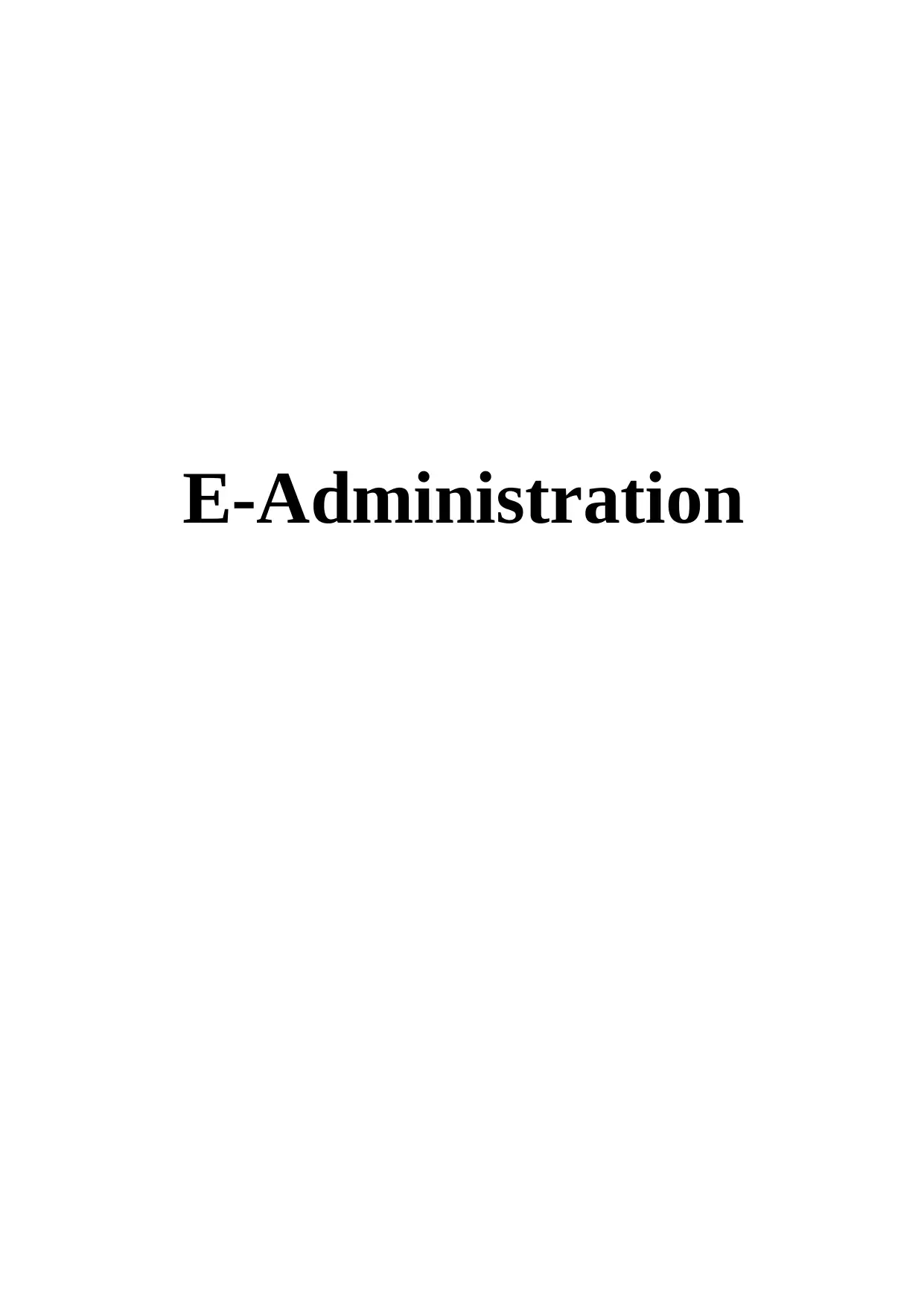
E-Administration
Paraphrase This Document
Need a fresh take? Get an instant paraphrase of this document with our AI Paraphraser
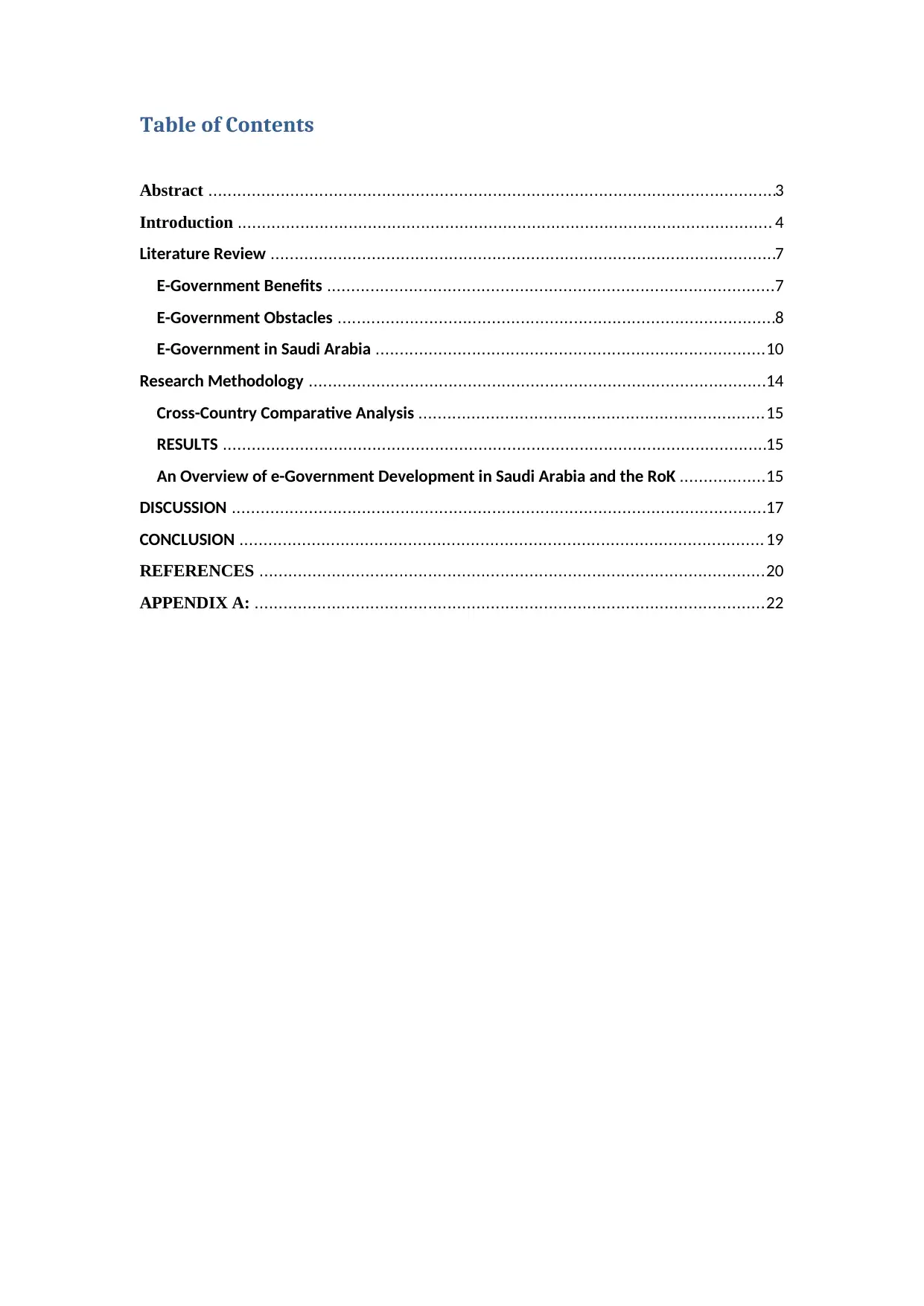
Table of Contents
Abstract ......................................................................................................................3
Introduction ............................................................................................................... 4
Literature Review .........................................................................................................7
E-Government Benefits .............................................................................................7
E-Government Obstacles ...........................................................................................8
E-Government in Saudi Arabia .................................................................................10
Research Methodology ...............................................................................................14
Cross-Country Comparative Analysis ........................................................................ 15
RESULTS .................................................................................................................15
An Overview of e-Government Development in Saudi Arabia and the RoK ..................15
DISCUSSION ...............................................................................................................17
CONCLUSION ............................................................................................................. 19
REFERENCES ......................................................................................................... 20
APPENDIX A: .......................................................................................................... 22
Abstract ......................................................................................................................3
Introduction ............................................................................................................... 4
Literature Review .........................................................................................................7
E-Government Benefits .............................................................................................7
E-Government Obstacles ...........................................................................................8
E-Government in Saudi Arabia .................................................................................10
Research Methodology ...............................................................................................14
Cross-Country Comparative Analysis ........................................................................ 15
RESULTS .................................................................................................................15
An Overview of e-Government Development in Saudi Arabia and the RoK ..................15
DISCUSSION ...............................................................................................................17
CONCLUSION ............................................................................................................. 19
REFERENCES ......................................................................................................... 20
APPENDIX A: .......................................................................................................... 22
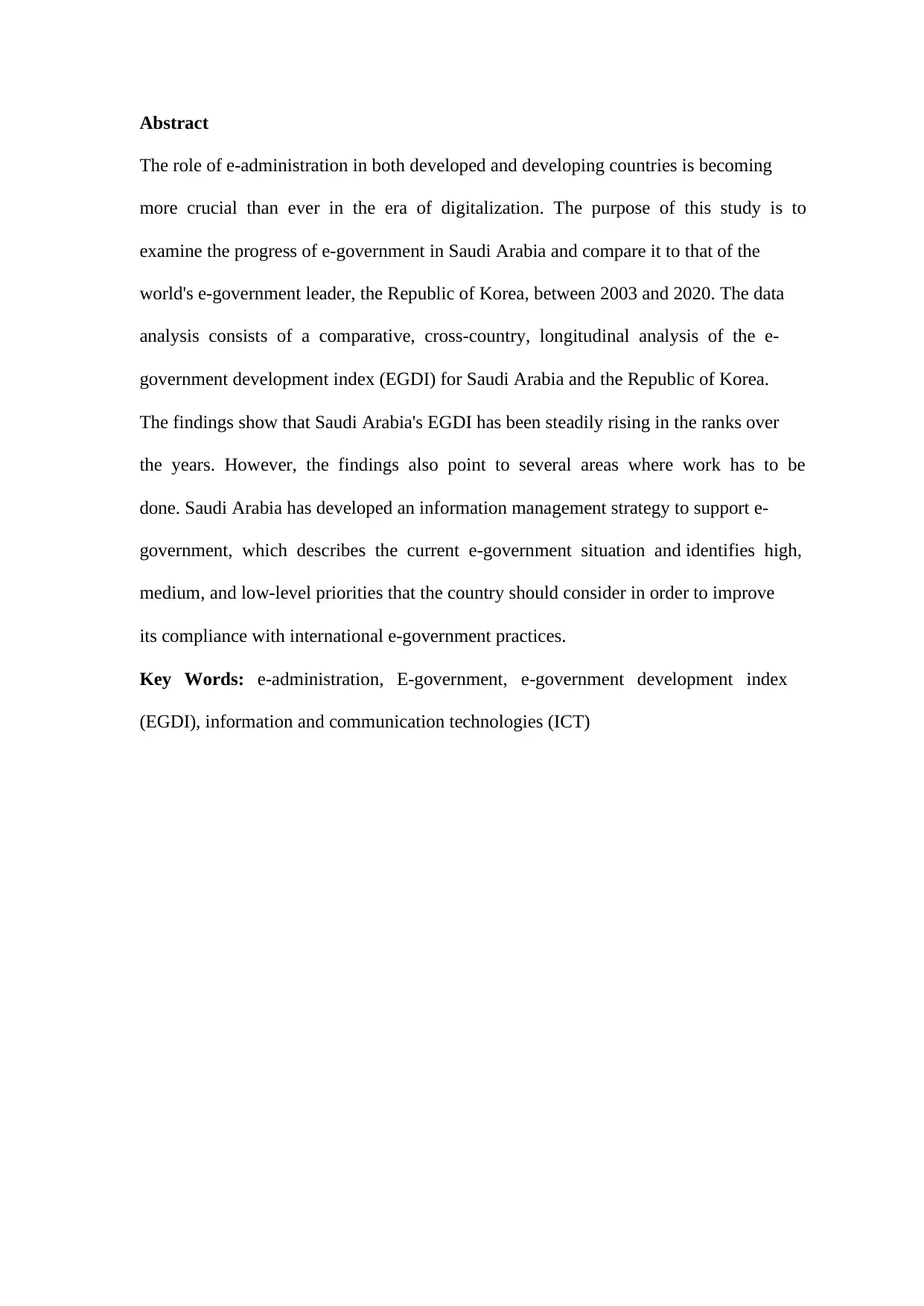
Abstract
The role of e-administration in both developed and developing countries is becoming
more crucial than ever in the era of digitalization. The purpose of this study is to
examine the progress of e-government in Saudi Arabia and compare it to that of the
world's e-government leader, the Republic of Korea, between 2003 and 2020. The data
analysis consists of a comparative, cross-country, longitudinal analysis of the e-
government development index (EGDI) for Saudi Arabia and the Republic of Korea.
The findings show that Saudi Arabia's EGDI has been steadily rising in the ranks over
the years. However, the findings also point to several areas where work has to be
done. Saudi Arabia has developed an information management strategy to support e-
government, which describes the current e-government situation and identifies high,
medium, and low-level priorities that the country should consider in order to improve
its compliance with international e-government practices.
Key Words: e-administration, E-government, e-government development index
(EGDI), information and communication technologies (ICT)
The role of e-administration in both developed and developing countries is becoming
more crucial than ever in the era of digitalization. The purpose of this study is to
examine the progress of e-government in Saudi Arabia and compare it to that of the
world's e-government leader, the Republic of Korea, between 2003 and 2020. The data
analysis consists of a comparative, cross-country, longitudinal analysis of the e-
government development index (EGDI) for Saudi Arabia and the Republic of Korea.
The findings show that Saudi Arabia's EGDI has been steadily rising in the ranks over
the years. However, the findings also point to several areas where work has to be
done. Saudi Arabia has developed an information management strategy to support e-
government, which describes the current e-government situation and identifies high,
medium, and low-level priorities that the country should consider in order to improve
its compliance with international e-government practices.
Key Words: e-administration, E-government, e-government development index
(EGDI), information and communication technologies (ICT)
⊘ This is a preview!⊘
Do you want full access?
Subscribe today to unlock all pages.

Trusted by 1+ million students worldwide
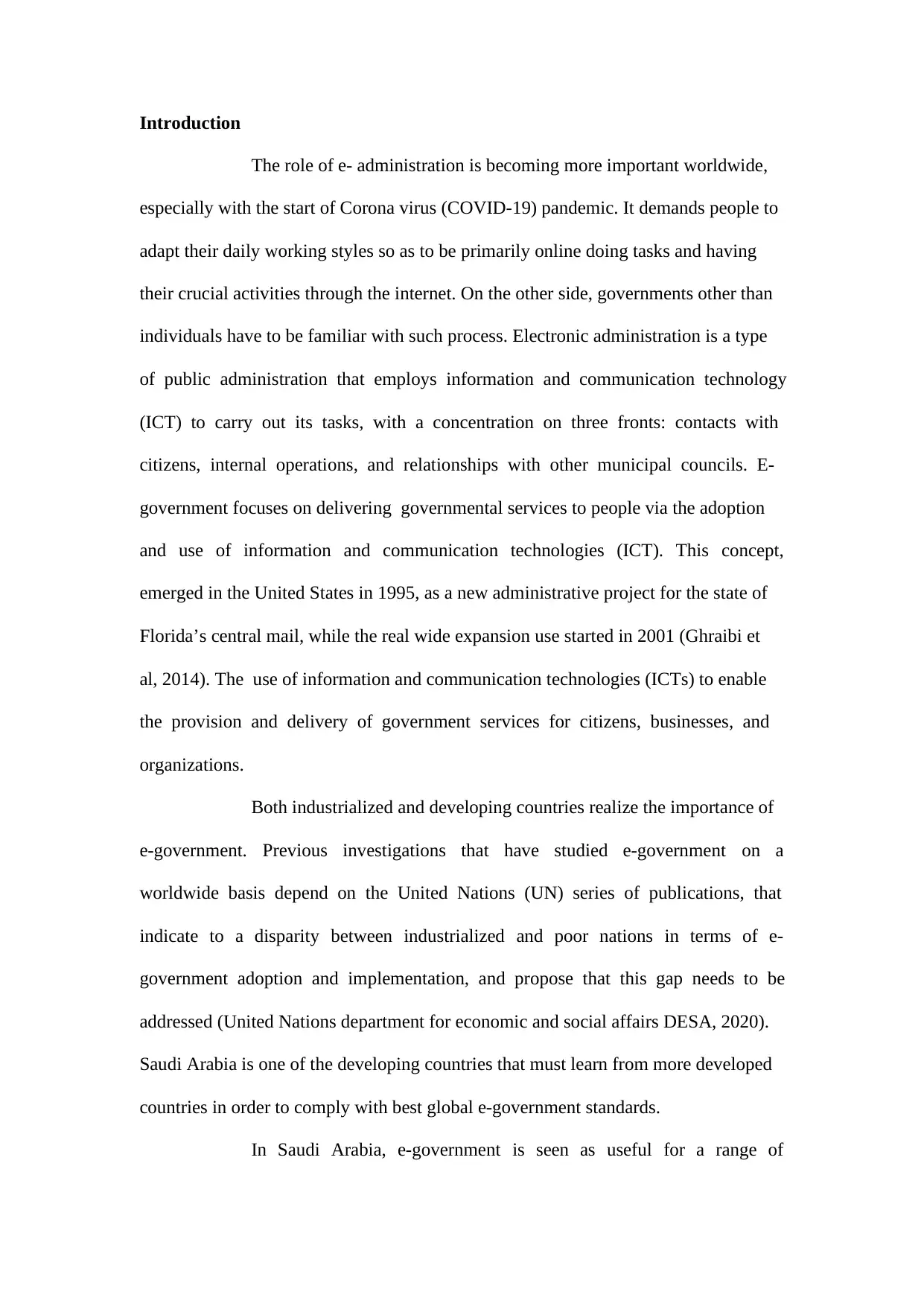
Introduction
The role of e- administration is becoming more important worldwide,
especially with the start of Corona virus (COVID-19) pandemic. It demands people to
adapt their daily working styles so as to be primarily online doing tasks and having
their crucial activities through the internet. On the other side, governments other than
individuals have to be familiar with such process. Electronic administration is a type
of public administration that employs information and communication technology
(ICT) to carry out its tasks, with a concentration on three fronts: contacts with
citizens, internal operations, and relationships with other municipal councils. E-
government focuses on delivering governmental services to people via the adoption
and use of information and communication technologies (ICT). This concept,
emerged in the United States in 1995, as a new administrative project for the state of
Florida’s central mail, while the real wide expansion use started in 2001 (Ghraibi et
al, 2014). The use of information and communication technologies (ICTs) to enable
the provision and delivery of government services for citizens, businesses, and
organizations.
Both industrialized and developing countries realize the importance of
e-government. Previous investigations that have studied e-government on a
worldwide basis depend on the United Nations (UN) series of publications, that
indicate to a disparity between industrialized and poor nations in terms of e-
government adoption and implementation, and propose that this gap needs to be
addressed (United Nations department for economic and social affairs DESA, 2020).
Saudi Arabia is one of the developing countries that must learn from more developed
countries in order to comply with best global e-government standards.
In Saudi Arabia, e-government is seen as useful for a range of
The role of e- administration is becoming more important worldwide,
especially with the start of Corona virus (COVID-19) pandemic. It demands people to
adapt their daily working styles so as to be primarily online doing tasks and having
their crucial activities through the internet. On the other side, governments other than
individuals have to be familiar with such process. Electronic administration is a type
of public administration that employs information and communication technology
(ICT) to carry out its tasks, with a concentration on three fronts: contacts with
citizens, internal operations, and relationships with other municipal councils. E-
government focuses on delivering governmental services to people via the adoption
and use of information and communication technologies (ICT). This concept,
emerged in the United States in 1995, as a new administrative project for the state of
Florida’s central mail, while the real wide expansion use started in 2001 (Ghraibi et
al, 2014). The use of information and communication technologies (ICTs) to enable
the provision and delivery of government services for citizens, businesses, and
organizations.
Both industrialized and developing countries realize the importance of
e-government. Previous investigations that have studied e-government on a
worldwide basis depend on the United Nations (UN) series of publications, that
indicate to a disparity between industrialized and poor nations in terms of e-
government adoption and implementation, and propose that this gap needs to be
addressed (United Nations department for economic and social affairs DESA, 2020).
Saudi Arabia is one of the developing countries that must learn from more developed
countries in order to comply with best global e-government standards.
In Saudi Arabia, e-government is seen as useful for a range of
Paraphrase This Document
Need a fresh take? Get an instant paraphrase of this document with our AI Paraphraser
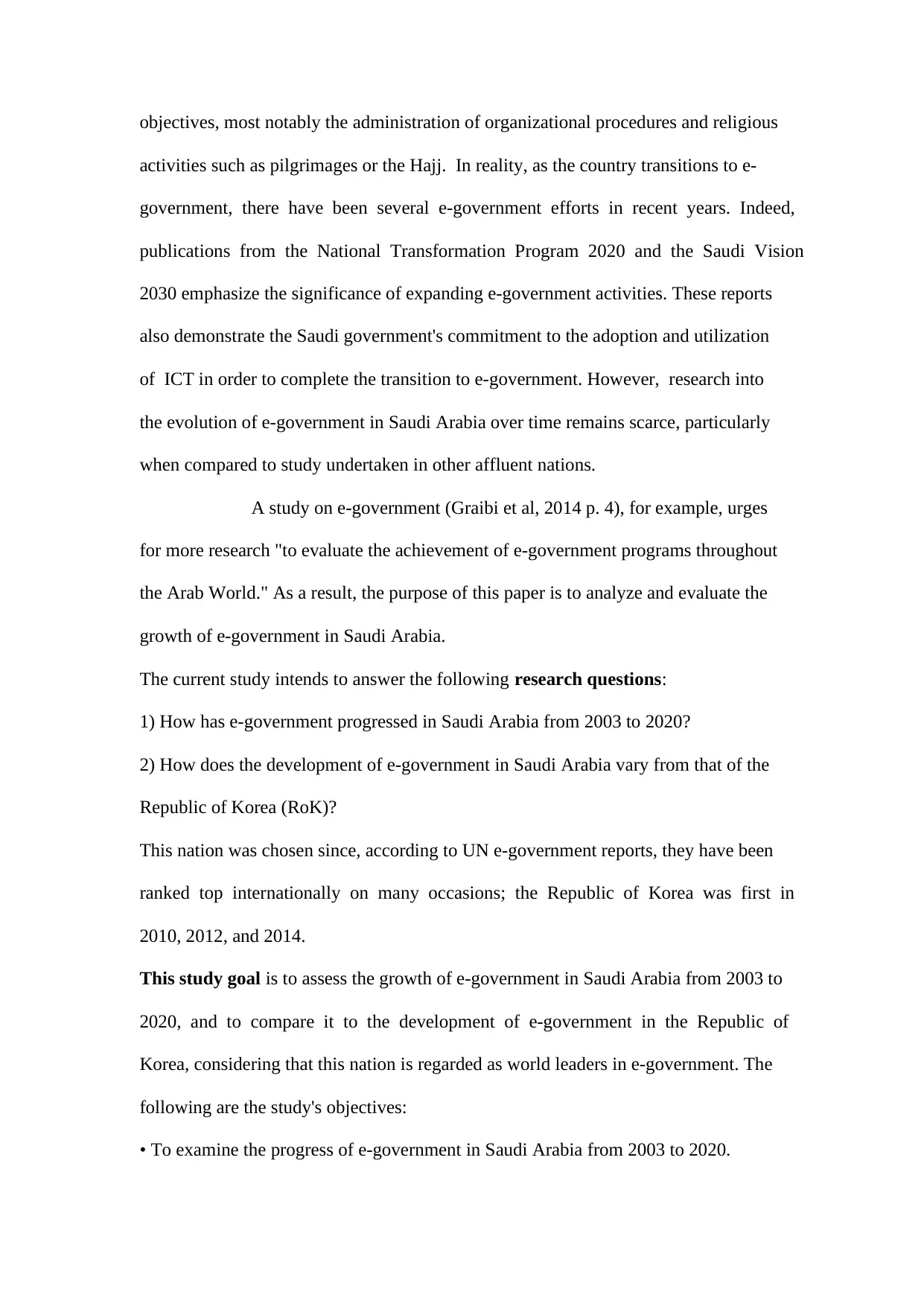
objectives, most notably the administration of organizational procedures and religious
activities such as pilgrimages or the Hajj. In reality, as the country transitions to e-
government, there have been several e-government efforts in recent years. Indeed,
publications from the National Transformation Program 2020 and the Saudi Vision
2030 emphasize the significance of expanding e-government activities. These reports
also demonstrate the Saudi government's commitment to the adoption and utilization
of ICT in order to complete the transition to e-government. However, research into
the evolution of e-government in Saudi Arabia over time remains scarce, particularly
when compared to study undertaken in other affluent nations.
A study on e-government (Graibi et al, 2014 p. 4), for example, urges
for more research "to evaluate the achievement of e-government programs throughout
the Arab World." As a result, the purpose of this paper is to analyze and evaluate the
growth of e-government in Saudi Arabia.
The current study intends to answer the following research questions:
1) How has e-government progressed in Saudi Arabia from 2003 to 2020?
2) How does the development of e-government in Saudi Arabia vary from that of the
Republic of Korea (RoK)?
This nation was chosen since, according to UN e-government reports, they have been
ranked top internationally on many occasions; the Republic of Korea was first in
2010, 2012, and 2014.
This study goal is to assess the growth of e-government in Saudi Arabia from 2003 to
2020, and to compare it to the development of e-government in the Republic of
Korea, considering that this nation is regarded as world leaders in e-government. The
following are the study's objectives:
• To examine the progress of e-government in Saudi Arabia from 2003 to 2020.
activities such as pilgrimages or the Hajj. In reality, as the country transitions to e-
government, there have been several e-government efforts in recent years. Indeed,
publications from the National Transformation Program 2020 and the Saudi Vision
2030 emphasize the significance of expanding e-government activities. These reports
also demonstrate the Saudi government's commitment to the adoption and utilization
of ICT in order to complete the transition to e-government. However, research into
the evolution of e-government in Saudi Arabia over time remains scarce, particularly
when compared to study undertaken in other affluent nations.
A study on e-government (Graibi et al, 2014 p. 4), for example, urges
for more research "to evaluate the achievement of e-government programs throughout
the Arab World." As a result, the purpose of this paper is to analyze and evaluate the
growth of e-government in Saudi Arabia.
The current study intends to answer the following research questions:
1) How has e-government progressed in Saudi Arabia from 2003 to 2020?
2) How does the development of e-government in Saudi Arabia vary from that of the
Republic of Korea (RoK)?
This nation was chosen since, according to UN e-government reports, they have been
ranked top internationally on many occasions; the Republic of Korea was first in
2010, 2012, and 2014.
This study goal is to assess the growth of e-government in Saudi Arabia from 2003 to
2020, and to compare it to the development of e-government in the Republic of
Korea, considering that this nation is regarded as world leaders in e-government. The
following are the study's objectives:
• To examine the progress of e-government in Saudi Arabia from 2003 to 2020.
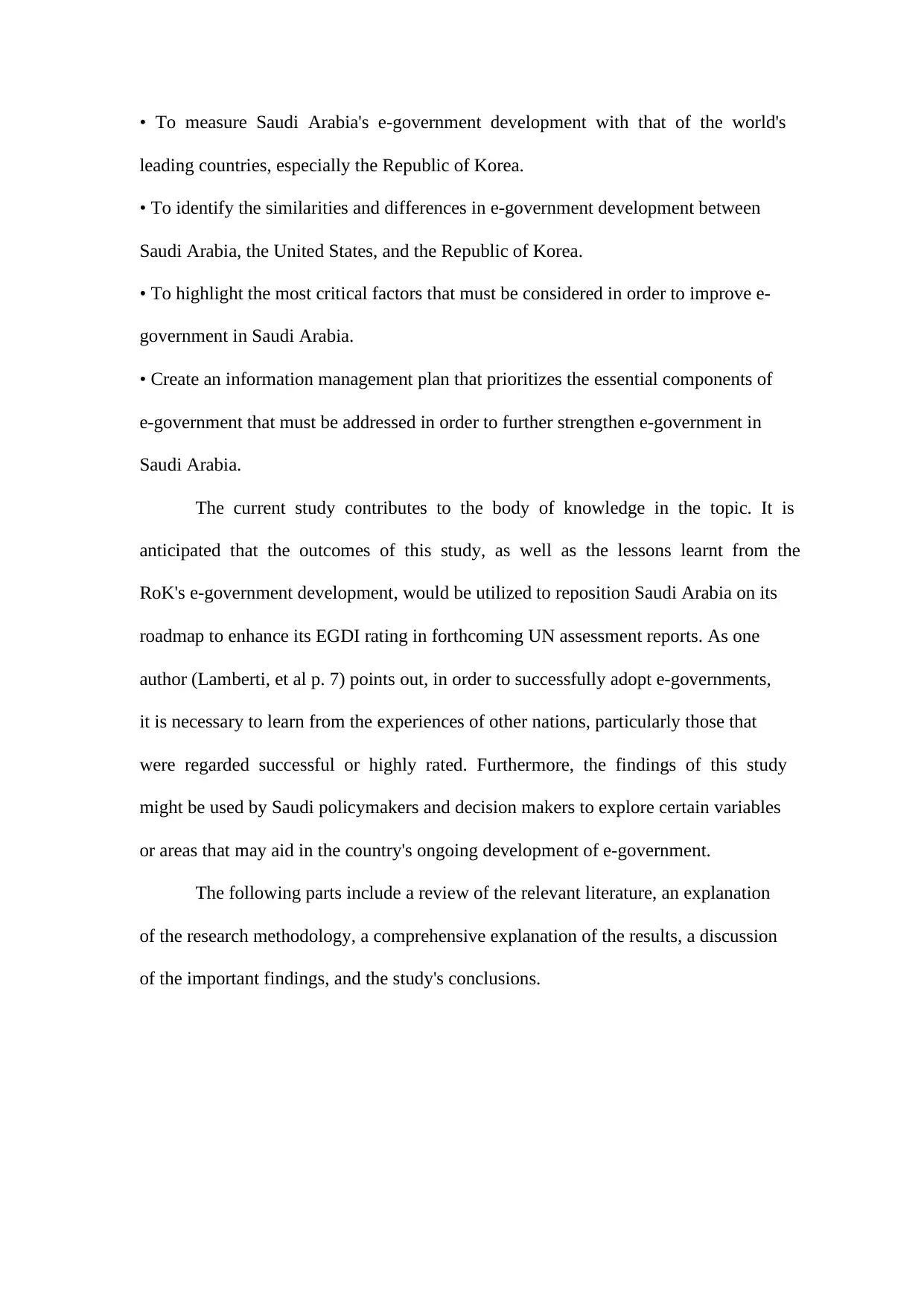
• To measure Saudi Arabia's e-government development with that of the world's
leading countries, especially the Republic of Korea.
• To identify the similarities and differences in e-government development between
Saudi Arabia, the United States, and the Republic of Korea.
• To highlight the most critical factors that must be considered in order to improve e-
government in Saudi Arabia.
• Create an information management plan that prioritizes the essential components of
e-government that must be addressed in order to further strengthen e-government in
Saudi Arabia.
The current study contributes to the body of knowledge in the topic. It is
anticipated that the outcomes of this study, as well as the lessons learnt from the
RoK's e-government development, would be utilized to reposition Saudi Arabia on its
roadmap to enhance its EGDI rating in forthcoming UN assessment reports. As one
author (Lamberti, et al p. 7) points out, in order to successfully adopt e-governments,
it is necessary to learn from the experiences of other nations, particularly those that
were regarded successful or highly rated. Furthermore, the findings of this study
might be used by Saudi policymakers and decision makers to explore certain variables
or areas that may aid in the country's ongoing development of e-government.
The following parts include a review of the relevant literature, an explanation
of the research methodology, a comprehensive explanation of the results, a discussion
of the important findings, and the study's conclusions.
leading countries, especially the Republic of Korea.
• To identify the similarities and differences in e-government development between
Saudi Arabia, the United States, and the Republic of Korea.
• To highlight the most critical factors that must be considered in order to improve e-
government in Saudi Arabia.
• Create an information management plan that prioritizes the essential components of
e-government that must be addressed in order to further strengthen e-government in
Saudi Arabia.
The current study contributes to the body of knowledge in the topic. It is
anticipated that the outcomes of this study, as well as the lessons learnt from the
RoK's e-government development, would be utilized to reposition Saudi Arabia on its
roadmap to enhance its EGDI rating in forthcoming UN assessment reports. As one
author (Lamberti, et al p. 7) points out, in order to successfully adopt e-governments,
it is necessary to learn from the experiences of other nations, particularly those that
were regarded successful or highly rated. Furthermore, the findings of this study
might be used by Saudi policymakers and decision makers to explore certain variables
or areas that may aid in the country's ongoing development of e-government.
The following parts include a review of the relevant literature, an explanation
of the research methodology, a comprehensive explanation of the results, a discussion
of the important findings, and the study's conclusions.
⊘ This is a preview!⊘
Do you want full access?
Subscribe today to unlock all pages.

Trusted by 1+ million students worldwide
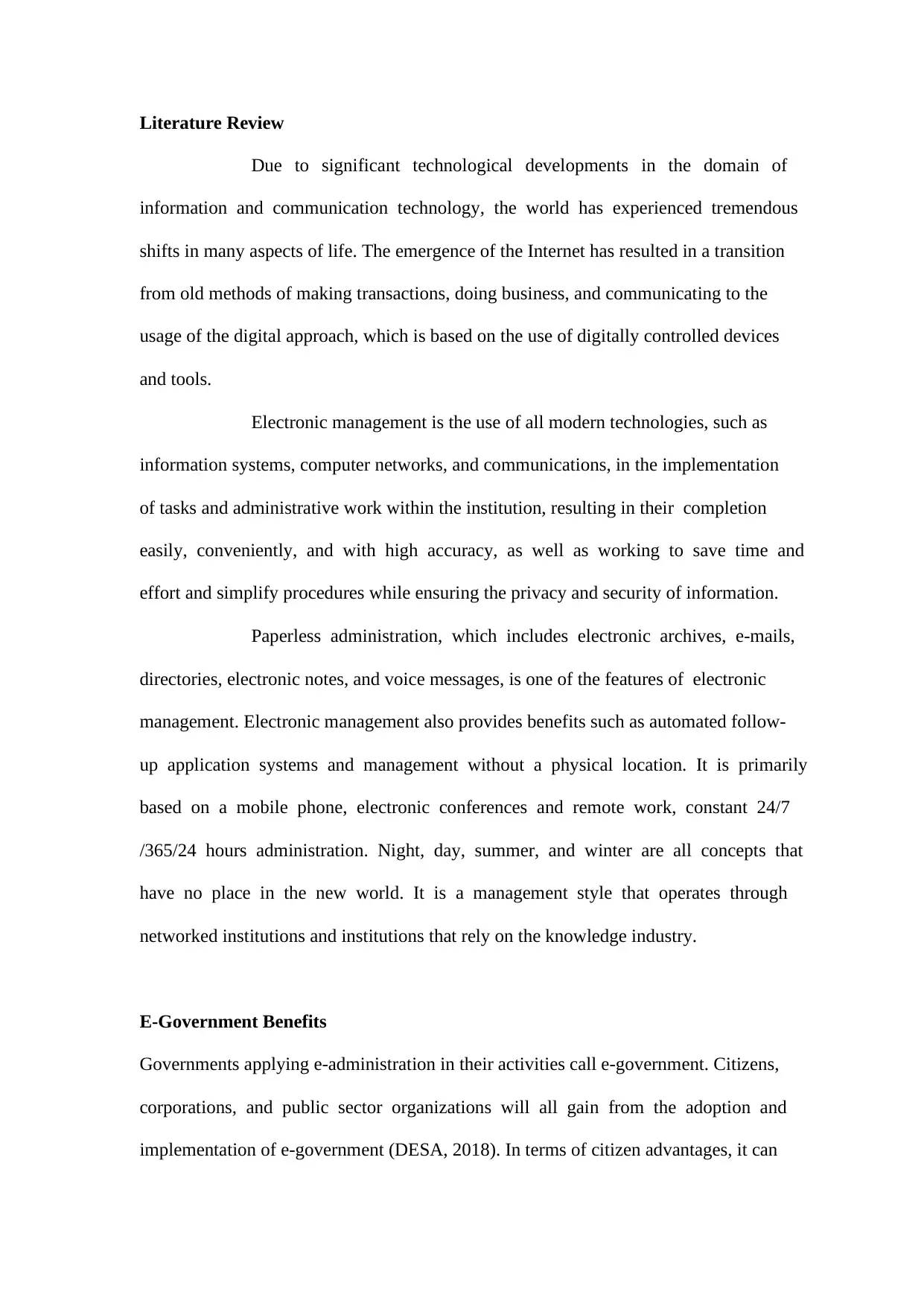
Literature Review
Due to significant technological developments in the domain of
information and communication technology, the world has experienced tremendous
shifts in many aspects of life. The emergence of the Internet has resulted in a transition
from old methods of making transactions, doing business, and communicating to the
usage of the digital approach, which is based on the use of digitally controlled devices
and tools.
Electronic management is the use of all modern technologies, such as
information systems, computer networks, and communications, in the implementation
of tasks and administrative work within the institution, resulting in their completion
easily, conveniently, and with high accuracy, as well as working to save time and
effort and simplify procedures while ensuring the privacy and security of information.
Paperless administration, which includes electronic archives, e-mails,
directories, electronic notes, and voice messages, is one of the features of electronic
management. Electronic management also provides benefits such as automated follow-
up application systems and management without a physical location. It is primarily
based on a mobile phone, electronic conferences and remote work, constant 24/7
/365/24 hours administration. Night, day, summer, and winter are all concepts that
have no place in the new world. It is a management style that operates through
networked institutions and institutions that rely on the knowledge industry.
E-Government Benefits
Governments applying e-administration in their activities call e-government. Citizens,
corporations, and public sector organizations will all gain from the adoption and
implementation of e-government (DESA, 2018). In terms of citizen advantages, it can
Due to significant technological developments in the domain of
information and communication technology, the world has experienced tremendous
shifts in many aspects of life. The emergence of the Internet has resulted in a transition
from old methods of making transactions, doing business, and communicating to the
usage of the digital approach, which is based on the use of digitally controlled devices
and tools.
Electronic management is the use of all modern technologies, such as
information systems, computer networks, and communications, in the implementation
of tasks and administrative work within the institution, resulting in their completion
easily, conveniently, and with high accuracy, as well as working to save time and
effort and simplify procedures while ensuring the privacy and security of information.
Paperless administration, which includes electronic archives, e-mails,
directories, electronic notes, and voice messages, is one of the features of electronic
management. Electronic management also provides benefits such as automated follow-
up application systems and management without a physical location. It is primarily
based on a mobile phone, electronic conferences and remote work, constant 24/7
/365/24 hours administration. Night, day, summer, and winter are all concepts that
have no place in the new world. It is a management style that operates through
networked institutions and institutions that rely on the knowledge industry.
E-Government Benefits
Governments applying e-administration in their activities call e-government. Citizens,
corporations, and public sector organizations will all gain from the adoption and
implementation of e-government (DESA, 2018). In terms of citizen advantages, it can
Paraphrase This Document
Need a fresh take? Get an instant paraphrase of this document with our AI Paraphraser
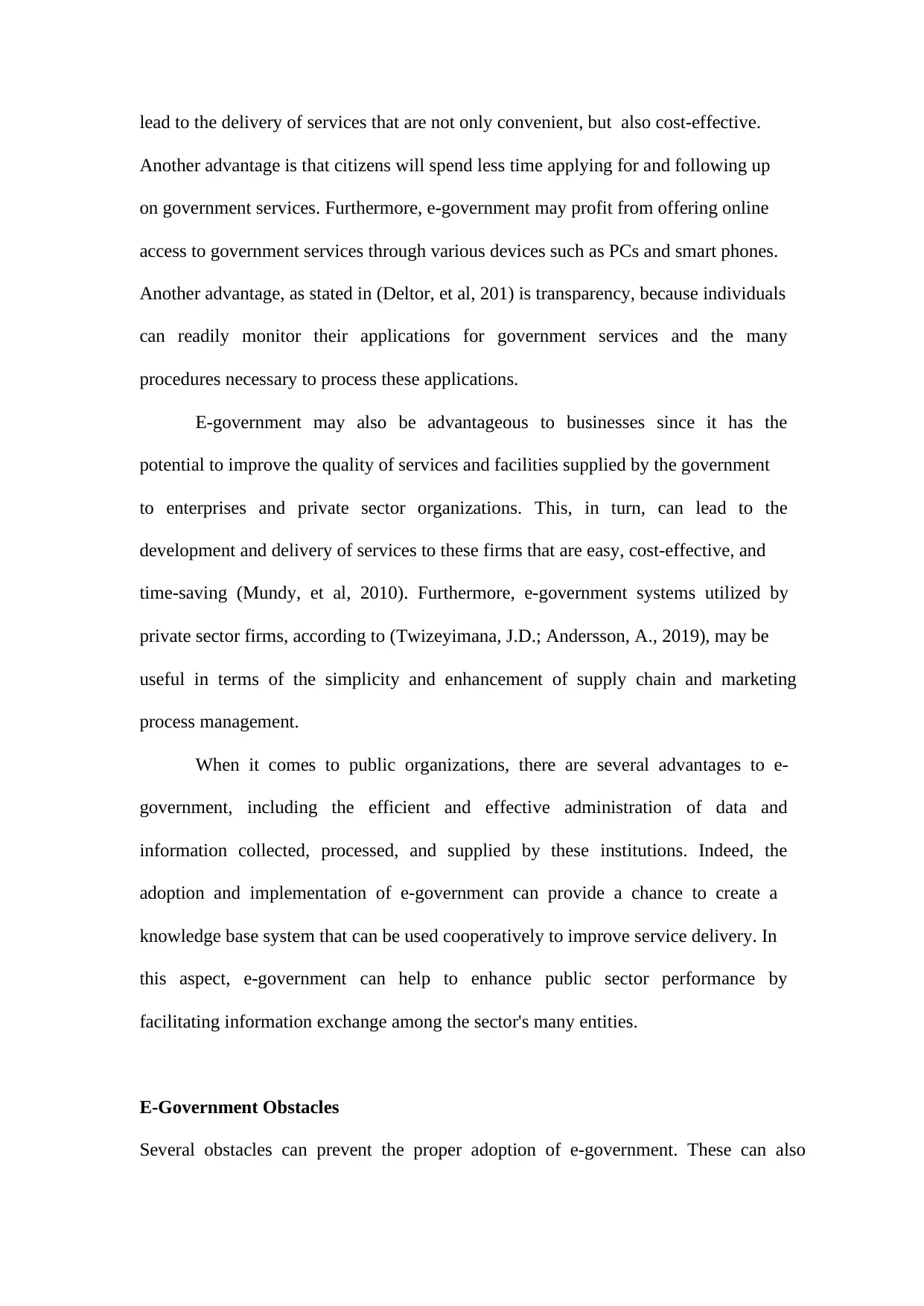
lead to the delivery of services that are not only convenient, but also cost-effective.
Another advantage is that citizens will spend less time applying for and following up
on government services. Furthermore, e-government may profit from offering online
access to government services through various devices such as PCs and smart phones.
Another advantage, as stated in (Deltor, et al, 201) is transparency, because individuals
can readily monitor their applications for government services and the many
procedures necessary to process these applications.
E-government may also be advantageous to businesses since it has the
potential to improve the quality of services and facilities supplied by the government
to enterprises and private sector organizations. This, in turn, can lead to the
development and delivery of services to these firms that are easy, cost-effective, and
time-saving (Mundy, et al, 2010). Furthermore, e-government systems utilized by
private sector firms, according to (Twizeyimana, J.D.; Andersson, A., 2019), may be
useful in terms of the simplicity and enhancement of supply chain and marketing
process management.
When it comes to public organizations, there are several advantages to e-
government, including the efficient and effective administration of data and
information collected, processed, and supplied by these institutions. Indeed, the
adoption and implementation of e-government can provide a chance to create a
knowledge base system that can be used cooperatively to improve service delivery. In
this aspect, e-government can help to enhance public sector performance by
facilitating information exchange among the sector's many entities.
E-Government Obstacles
Several obstacles can prevent the proper adoption of e-government. These can also
Another advantage is that citizens will spend less time applying for and following up
on government services. Furthermore, e-government may profit from offering online
access to government services through various devices such as PCs and smart phones.
Another advantage, as stated in (Deltor, et al, 201) is transparency, because individuals
can readily monitor their applications for government services and the many
procedures necessary to process these applications.
E-government may also be advantageous to businesses since it has the
potential to improve the quality of services and facilities supplied by the government
to enterprises and private sector organizations. This, in turn, can lead to the
development and delivery of services to these firms that are easy, cost-effective, and
time-saving (Mundy, et al, 2010). Furthermore, e-government systems utilized by
private sector firms, according to (Twizeyimana, J.D.; Andersson, A., 2019), may be
useful in terms of the simplicity and enhancement of supply chain and marketing
process management.
When it comes to public organizations, there are several advantages to e-
government, including the efficient and effective administration of data and
information collected, processed, and supplied by these institutions. Indeed, the
adoption and implementation of e-government can provide a chance to create a
knowledge base system that can be used cooperatively to improve service delivery. In
this aspect, e-government can help to enhance public sector performance by
facilitating information exchange among the sector's many entities.
E-Government Obstacles
Several obstacles can prevent the proper adoption of e-government. These can also
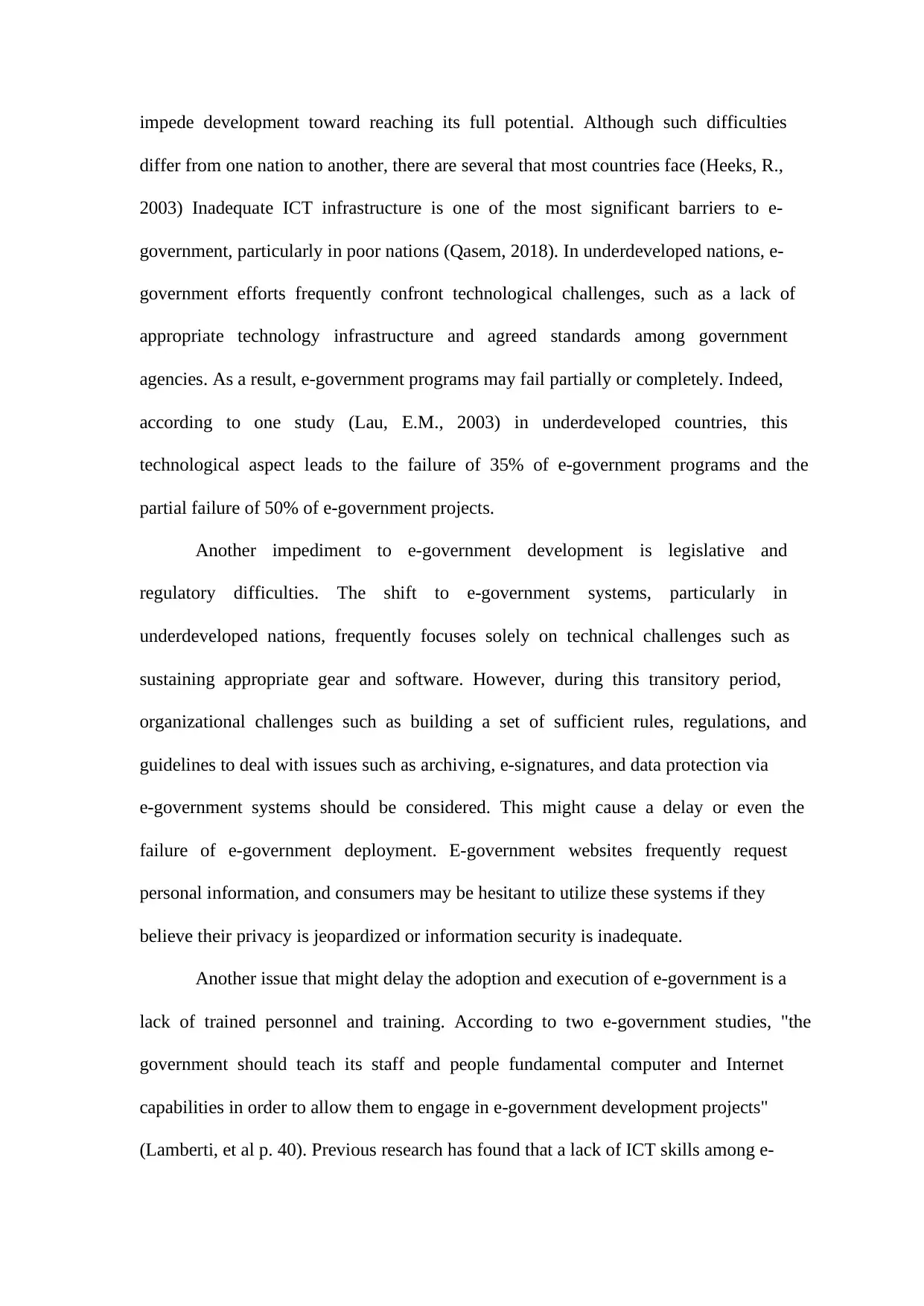
impede development toward reaching its full potential. Although such difficulties
differ from one nation to another, there are several that most countries face (Heeks, R.,
2003) Inadequate ICT infrastructure is one of the most significant barriers to e-
government, particularly in poor nations (Qasem, 2018). In underdeveloped nations, e-
government efforts frequently confront technological challenges, such as a lack of
appropriate technology infrastructure and agreed standards among government
agencies. As a result, e-government programs may fail partially or completely. Indeed,
according to one study (Lau, E.M., 2003) in underdeveloped countries, this
technological aspect leads to the failure of 35% of e-government programs and the
partial failure of 50% of e-government projects.
Another impediment to e-government development is legislative and
regulatory difficulties. The shift to e-government systems, particularly in
underdeveloped nations, frequently focuses solely on technical challenges such as
sustaining appropriate gear and software. However, during this transitory period,
organizational challenges such as building a set of sufficient rules, regulations, and
guidelines to deal with issues such as archiving, e-signatures, and data protection via
e-government systems should be considered. This might cause a delay or even the
failure of e-government deployment. E-government websites frequently request
personal information, and consumers may be hesitant to utilize these systems if they
believe their privacy is jeopardized or information security is inadequate.
Another issue that might delay the adoption and execution of e-government is a
lack of trained personnel and training. According to two e-government studies, "the
government should teach its staff and people fundamental computer and Internet
capabilities in order to allow them to engage in e-government development projects"
(Lamberti, et al p. 40). Previous research has found that a lack of ICT skills among e-
differ from one nation to another, there are several that most countries face (Heeks, R.,
2003) Inadequate ICT infrastructure is one of the most significant barriers to e-
government, particularly in poor nations (Qasem, 2018). In underdeveloped nations, e-
government efforts frequently confront technological challenges, such as a lack of
appropriate technology infrastructure and agreed standards among government
agencies. As a result, e-government programs may fail partially or completely. Indeed,
according to one study (Lau, E.M., 2003) in underdeveloped countries, this
technological aspect leads to the failure of 35% of e-government programs and the
partial failure of 50% of e-government projects.
Another impediment to e-government development is legislative and
regulatory difficulties. The shift to e-government systems, particularly in
underdeveloped nations, frequently focuses solely on technical challenges such as
sustaining appropriate gear and software. However, during this transitory period,
organizational challenges such as building a set of sufficient rules, regulations, and
guidelines to deal with issues such as archiving, e-signatures, and data protection via
e-government systems should be considered. This might cause a delay or even the
failure of e-government deployment. E-government websites frequently request
personal information, and consumers may be hesitant to utilize these systems if they
believe their privacy is jeopardized or information security is inadequate.
Another issue that might delay the adoption and execution of e-government is a
lack of trained personnel and training. According to two e-government studies, "the
government should teach its staff and people fundamental computer and Internet
capabilities in order to allow them to engage in e-government development projects"
(Lamberti, et al p. 40). Previous research has found that a lack of ICT skills among e-
⊘ This is a preview!⊘
Do you want full access?
Subscribe today to unlock all pages.

Trusted by 1+ million students worldwide
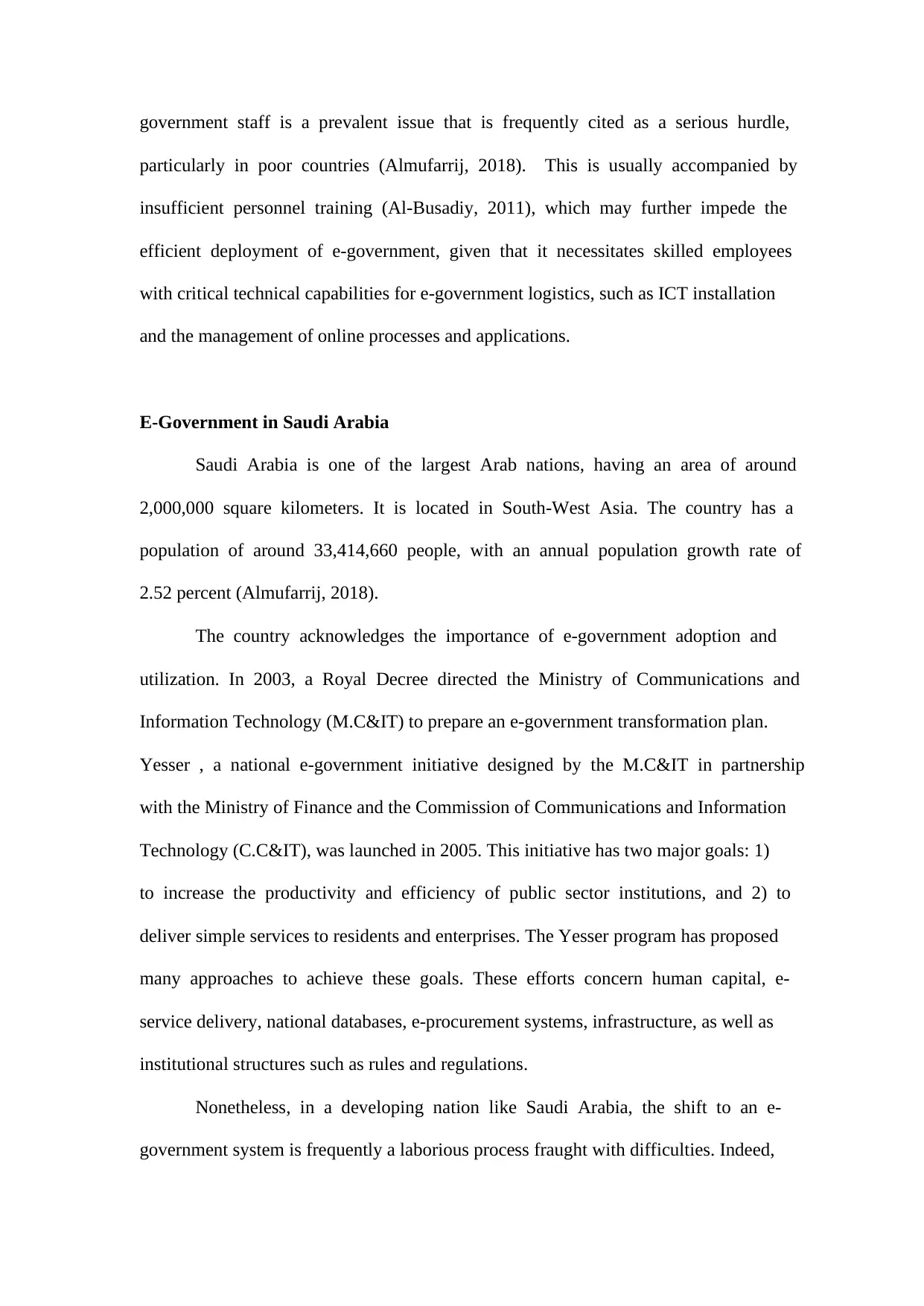
government staff is a prevalent issue that is frequently cited as a serious hurdle,
particularly in poor countries (Almufarrij, 2018). This is usually accompanied by
insufficient personnel training (Al-Busadiy, 2011), which may further impede the
efficient deployment of e-government, given that it necessitates skilled employees
with critical technical capabilities for e-government logistics, such as ICT installation
and the management of online processes and applications.
E-Government in Saudi Arabia
Saudi Arabia is one of the largest Arab nations, having an area of around
2,000,000 square kilometers. It is located in South-West Asia. The country has a
population of around 33,414,660 people, with an annual population growth rate of
2.52 percent (Almufarrij, 2018).
The country acknowledges the importance of e-government adoption and
utilization. In 2003, a Royal Decree directed the Ministry of Communications and
Information Technology (M.C&IT) to prepare an e-government transformation plan.
Yesser , a national e-government initiative designed by the M.C&IT in partnership
with the Ministry of Finance and the Commission of Communications and Information
Technology (C.C&IT), was launched in 2005. This initiative has two major goals: 1)
to increase the productivity and efficiency of public sector institutions, and 2) to
deliver simple services to residents and enterprises. The Yesser program has proposed
many approaches to achieve these goals. These efforts concern human capital, e-
service delivery, national databases, e-procurement systems, infrastructure, as well as
institutional structures such as rules and regulations.
Nonetheless, in a developing nation like Saudi Arabia, the shift to an e-
government system is frequently a laborious process fraught with difficulties. Indeed,
particularly in poor countries (Almufarrij, 2018). This is usually accompanied by
insufficient personnel training (Al-Busadiy, 2011), which may further impede the
efficient deployment of e-government, given that it necessitates skilled employees
with critical technical capabilities for e-government logistics, such as ICT installation
and the management of online processes and applications.
E-Government in Saudi Arabia
Saudi Arabia is one of the largest Arab nations, having an area of around
2,000,000 square kilometers. It is located in South-West Asia. The country has a
population of around 33,414,660 people, with an annual population growth rate of
2.52 percent (Almufarrij, 2018).
The country acknowledges the importance of e-government adoption and
utilization. In 2003, a Royal Decree directed the Ministry of Communications and
Information Technology (M.C&IT) to prepare an e-government transformation plan.
Yesser , a national e-government initiative designed by the M.C&IT in partnership
with the Ministry of Finance and the Commission of Communications and Information
Technology (C.C&IT), was launched in 2005. This initiative has two major goals: 1)
to increase the productivity and efficiency of public sector institutions, and 2) to
deliver simple services to residents and enterprises. The Yesser program has proposed
many approaches to achieve these goals. These efforts concern human capital, e-
service delivery, national databases, e-procurement systems, infrastructure, as well as
institutional structures such as rules and regulations.
Nonetheless, in a developing nation like Saudi Arabia, the shift to an e-
government system is frequently a laborious process fraught with difficulties. Indeed,
Paraphrase This Document
Need a fresh take? Get an instant paraphrase of this document with our AI Paraphraser
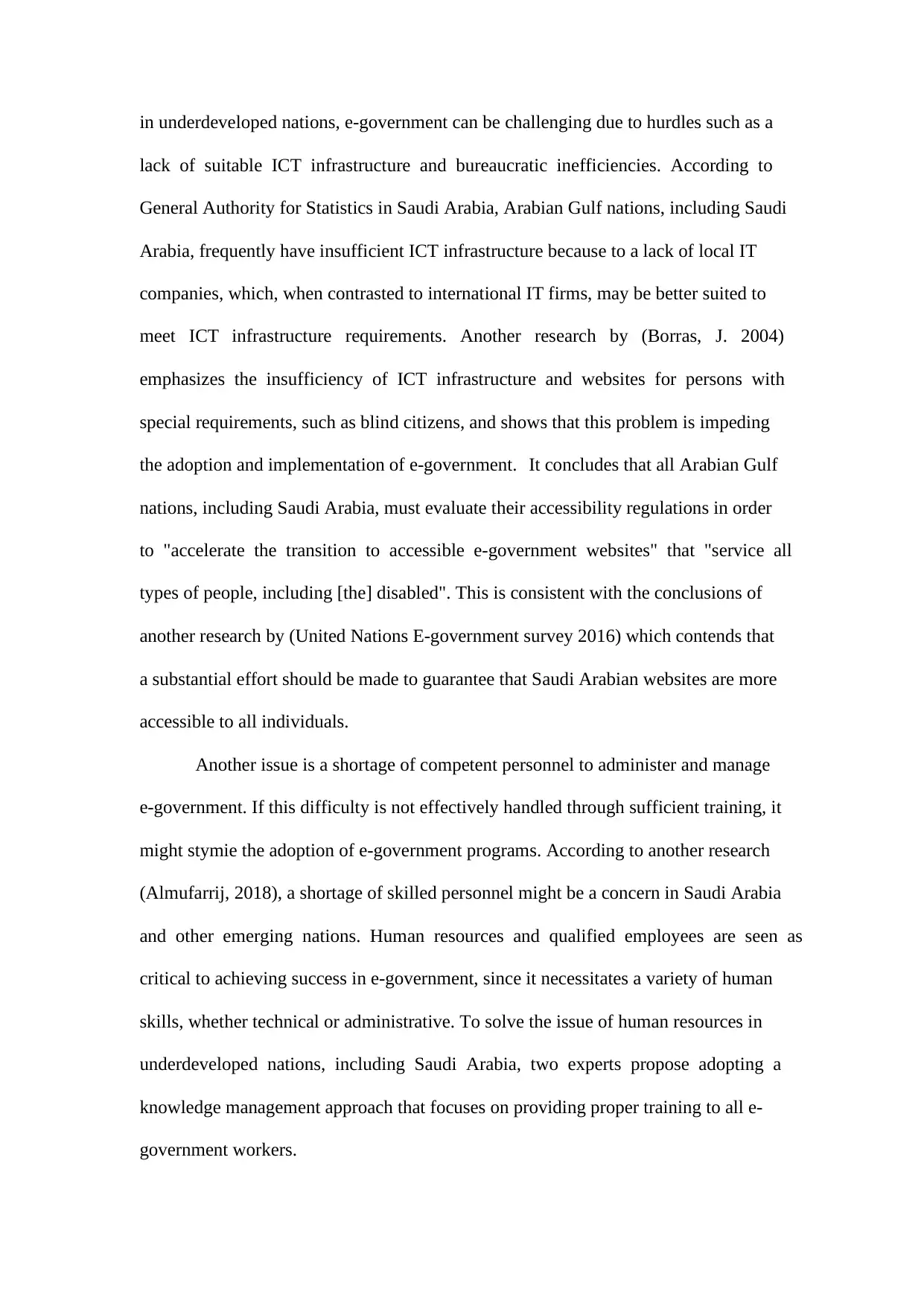
in underdeveloped nations, e-government can be challenging due to hurdles such as a
lack of suitable ICT infrastructure and bureaucratic inefficiencies. According to
General Authority for Statistics in Saudi Arabia, Arabian Gulf nations, including Saudi
Arabia, frequently have insufficient ICT infrastructure because to a lack of local IT
companies, which, when contrasted to international IT firms, may be better suited to
meet ICT infrastructure requirements. Another research by (Borras, J. 2004)
emphasizes the insufficiency of ICT infrastructure and websites for persons with
special requirements, such as blind citizens, and shows that this problem is impeding
the adoption and implementation of e-government. It concludes that all Arabian Gulf
nations, including Saudi Arabia, must evaluate their accessibility regulations in order
to "accelerate the transition to accessible e-government websites" that "service all
types of people, including [the] disabled". This is consistent with the conclusions of
another research by (United Nations E-government survey 2016) which contends that
a substantial effort should be made to guarantee that Saudi Arabian websites are more
accessible to all individuals.
Another issue is a shortage of competent personnel to administer and manage
e-government. If this difficulty is not effectively handled through sufficient training, it
might stymie the adoption of e-government programs. According to another research
(Almufarrij, 2018), a shortage of skilled personnel might be a concern in Saudi Arabia
and other emerging nations. Human resources and qualified employees are seen as
critical to achieving success in e-government, since it necessitates a variety of human
skills, whether technical or administrative. To solve the issue of human resources in
underdeveloped nations, including Saudi Arabia, two experts propose adopting a
knowledge management approach that focuses on providing proper training to all e-
government workers.
lack of suitable ICT infrastructure and bureaucratic inefficiencies. According to
General Authority for Statistics in Saudi Arabia, Arabian Gulf nations, including Saudi
Arabia, frequently have insufficient ICT infrastructure because to a lack of local IT
companies, which, when contrasted to international IT firms, may be better suited to
meet ICT infrastructure requirements. Another research by (Borras, J. 2004)
emphasizes the insufficiency of ICT infrastructure and websites for persons with
special requirements, such as blind citizens, and shows that this problem is impeding
the adoption and implementation of e-government. It concludes that all Arabian Gulf
nations, including Saudi Arabia, must evaluate their accessibility regulations in order
to "accelerate the transition to accessible e-government websites" that "service all
types of people, including [the] disabled". This is consistent with the conclusions of
another research by (United Nations E-government survey 2016) which contends that
a substantial effort should be made to guarantee that Saudi Arabian websites are more
accessible to all individuals.
Another issue is a shortage of competent personnel to administer and manage
e-government. If this difficulty is not effectively handled through sufficient training, it
might stymie the adoption of e-government programs. According to another research
(Almufarrij, 2018), a shortage of skilled personnel might be a concern in Saudi Arabia
and other emerging nations. Human resources and qualified employees are seen as
critical to achieving success in e-government, since it necessitates a variety of human
skills, whether technical or administrative. To solve the issue of human resources in
underdeveloped nations, including Saudi Arabia, two experts propose adopting a
knowledge management approach that focuses on providing proper training to all e-
government workers.
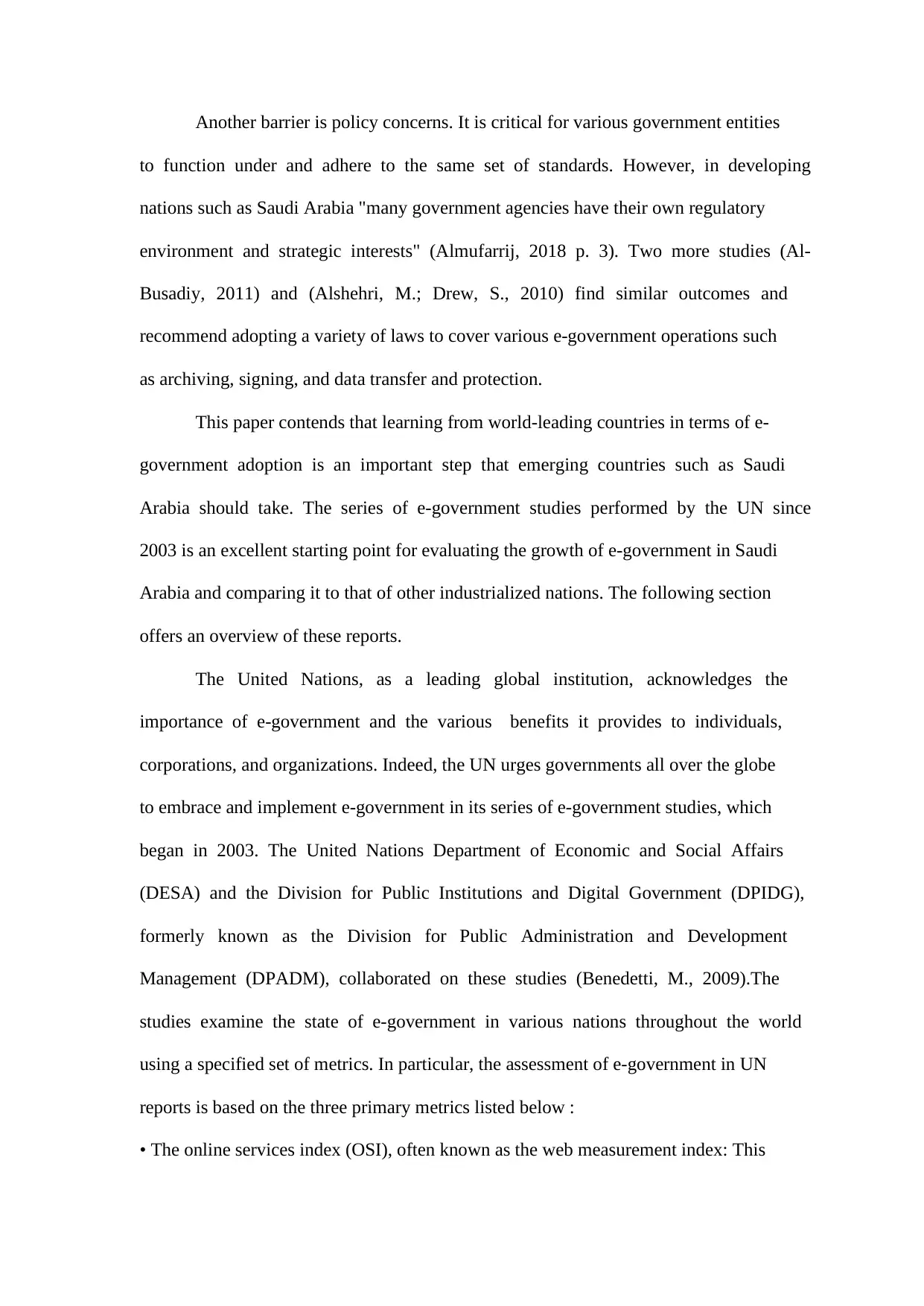
Another barrier is policy concerns. It is critical for various government entities
to function under and adhere to the same set of standards. However, in developing
nations such as Saudi Arabia "many government agencies have their own regulatory
environment and strategic interests" (Almufarrij, 2018 p. 3). Two more studies (Al-
Busadiy, 2011) and (Alshehri, M.; Drew, S., 2010) find similar outcomes and
recommend adopting a variety of laws to cover various e-government operations such
as archiving, signing, and data transfer and protection.
This paper contends that learning from world-leading countries in terms of e-
government adoption is an important step that emerging countries such as Saudi
Arabia should take. The series of e-government studies performed by the UN since
2003 is an excellent starting point for evaluating the growth of e-government in Saudi
Arabia and comparing it to that of other industrialized nations. The following section
offers an overview of these reports.
The United Nations, as a leading global institution, acknowledges the
importance of e-government and the various benefits it provides to individuals,
corporations, and organizations. Indeed, the UN urges governments all over the globe
to embrace and implement e-government in its series of e-government studies, which
began in 2003. The United Nations Department of Economic and Social Affairs
(DESA) and the Division for Public Institutions and Digital Government (DPIDG),
formerly known as the Division for Public Administration and Development
Management (DPADM), collaborated on these studies (Benedetti, M., 2009).The
studies examine the state of e-government in various nations throughout the world
using a specified set of metrics. In particular, the assessment of e-government in UN
reports is based on the three primary metrics listed below :
• The online services index (OSI), often known as the web measurement index: This
to function under and adhere to the same set of standards. However, in developing
nations such as Saudi Arabia "many government agencies have their own regulatory
environment and strategic interests" (Almufarrij, 2018 p. 3). Two more studies (Al-
Busadiy, 2011) and (Alshehri, M.; Drew, S., 2010) find similar outcomes and
recommend adopting a variety of laws to cover various e-government operations such
as archiving, signing, and data transfer and protection.
This paper contends that learning from world-leading countries in terms of e-
government adoption is an important step that emerging countries such as Saudi
Arabia should take. The series of e-government studies performed by the UN since
2003 is an excellent starting point for evaluating the growth of e-government in Saudi
Arabia and comparing it to that of other industrialized nations. The following section
offers an overview of these reports.
The United Nations, as a leading global institution, acknowledges the
importance of e-government and the various benefits it provides to individuals,
corporations, and organizations. Indeed, the UN urges governments all over the globe
to embrace and implement e-government in its series of e-government studies, which
began in 2003. The United Nations Department of Economic and Social Affairs
(DESA) and the Division for Public Institutions and Digital Government (DPIDG),
formerly known as the Division for Public Administration and Development
Management (DPADM), collaborated on these studies (Benedetti, M., 2009).The
studies examine the state of e-government in various nations throughout the world
using a specified set of metrics. In particular, the assessment of e-government in UN
reports is based on the three primary metrics listed below :
• The online services index (OSI), often known as the web measurement index: This
⊘ This is a preview!⊘
Do you want full access?
Subscribe today to unlock all pages.

Trusted by 1+ million students worldwide
1 out of 22
Related Documents
Your All-in-One AI-Powered Toolkit for Academic Success.
+13062052269
info@desklib.com
Available 24*7 on WhatsApp / Email
![[object Object]](/_next/static/media/star-bottom.7253800d.svg)
Unlock your academic potential
Copyright © 2020–2025 A2Z Services. All Rights Reserved. Developed and managed by ZUCOL.




